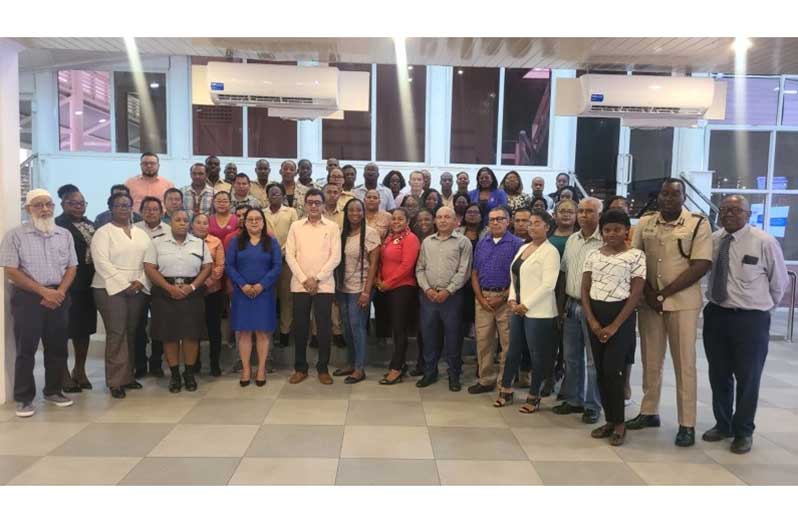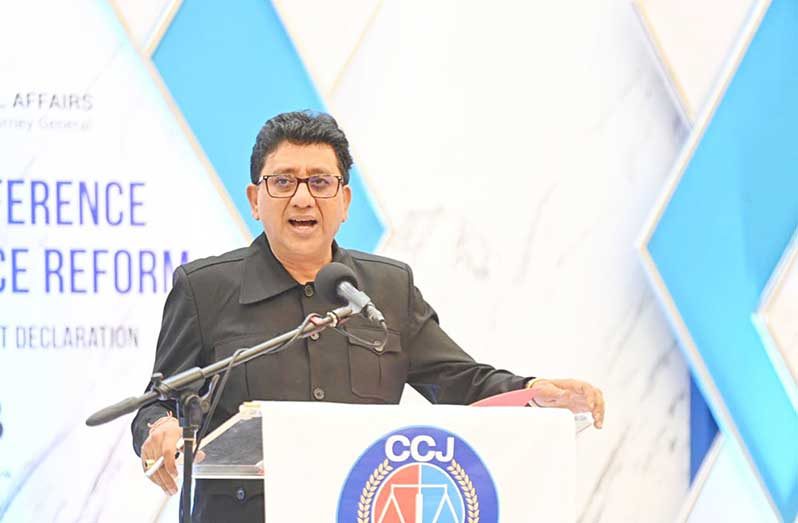By Feona Morrison
HOW can restorative justice transform criminal justice systems in the Caribbean? This was the focal point of Attorney-General Anil Nandlall’s address at the recently concluded First Legal Conference on Criminal Justice Reform which was held at the Marriott Hotel.
In his presentation, titled, “The role of restorative justice in the criminal justice system—making the cultural shift”, he emphatically stated that alternative methods of settling disputes are not just a trend, but a necessary evolution in the justice system.
While there are many different forms of alternative dispute resolution (ADR), such as mediation and arbitration, Nandlall’s research focused on the role that restorative justice techniques play in reducing the burden on courts and providing satisfactory outcomes for all parties involved.
Though new in the Caribbean, he said restorative justice has been around for nearly 50 years, and is widely practised in first world jurisdictions, including, North America and Europe.
He said that the United Nations Congress on Crime Prevention and Criminal Justice has recognised restorative justice as an essential tool for improving criminal justice reform since 2005, and has advised all member states to incorporate it into their legal frameworks.
Nandlall stated that novel concepts such as restorative justice have emerged because the traditional systems of punishment have simply not worked.
“History and experience have taught us that punitive sanctions are not the solution. We have tried protracted custodial sentences; we have tried the death penalty, we have tried the cat o’ nine tails, we have tried hard labour, we have tried solitary confinement but what is the result? Has there been a reduction in crime? Were these punitive sanctions a deterrent? The answer is no,” the Attorney-General reasoned.
The unpleasant reality, as he put it, is that crime has not only escalated, but has increased to unprecedented levels, despite the use of highly punitive sanctions, including the death penalty.
This morbid reality, he noted, demonstrably establishes, beyond doubt, that penal sanctions and the conventional approach to punishment have abysmally failed to achieve the conceptual objective of deterrence.
Additionally, he pointed out that the skyrocketing rate of recidivism further establishes that the penal objectives of rehabilitation and reformation of the offender are more elusive than attainable.
HEALING OVER PUNISHHMENT
Like plea bargaining, Nandlall explained that restorative justice brings the offender and the victim face-to-face in a conciliatory atmosphere at a mediation table, instead of putting them against each other in an adversarial amphitheatre-type setting of a criminal trial court.
By embracing restorative justice, he noted, the criminal justice system can move towards a model that prioritises healing over punishment, ultimately leading to safer and more cohesive communities.
Nandlall said that restorative justice contains three fundamental ingredients: Victim involvement, community involvement, and offender reintegration.

“In the traditional criminal process,” he said, “the State is the victim; not the individual. The offender is sentenced, and the victim hardly has any involvement. On the other hand, under restorative justice, the victim takes centre stage. Property may be restored, compensation paid, dignity restored, a sense of empowerment conferred, relationship with accused repaired, and a feeling that justice has been done is left in the mind of the victim.
“In restorative justice, the community also plays a pivotal role. Invariably, the persons who preside over the engagement between the offender and the victim are drawn from the community – from the religious institutions, from community-based organisations, and even teachers from the schools. The offender is offered an opportunity to express contrition and repair the relationship not only with the victim but with the community which may have been outraged by his conduct.
“The public shaming aspect associated with the criminal charge, or worse yet, a conviction, under the traditional system disappears. The ostracism to which such an offender is normally subjected is removed. Significantly, the root cause of the problem between the victim and the offender is normally identified and addressed with the assistance of the community. In the end, this process makes it more conducive for the offender to be reintegrated into the community.”
WINNING FORMULA
Meanwhile, Attorney-General Nandlall declared that restorative justice has finally been formally included into Caribbean legal systems, calling it a long-overdue reform.
He cited Jamaica as the pioneering jurisdiction with its Law Reform (Miscellaneous Amendments) (Restorative Justice) Act of 2016.
He pointed out that research has shown that Jamaica’s restorative justice programme has a 90 per cent resolution and settlement rate for cases that are referred.
If this rate of success can be replicated throughout the Caribbean, Nandlall expressed “then we would have found a winning formula.”
In Guyana, significant efforts are underway to prepare for the implementation of restorative justice. Extensive training sessions have been conducted for judges, magistrates, prosecutors, police officers, prison officers, probation officers, and community leaders.
The training also encompasses religious leaders and teachers, with plans to introduce restorative practices within schools. In the hinterland regions, training has been extended to toshaos, the leaders in Amerindian communities.
A Restorative Justice Centre has been established, led by a qualified director, to oversee the application of restorative justice as per the Restorative Justice Act, which was enacted in 2022.
Given Guyana’s vast geography and dispersed population, the Attorney-General admitted that implementing restorative justice nationwide presents a substantial challenge.
To address this, he has initiated the integration of Restorative Justice Units within each Probation Department across Guyana, which are under the Ministry of Human Services and Social Security.
These departments maintain a functional relationship with the country’s court systems, particularly the Magistrates’ Courts.
By aligning the services of probation officers and restorative justice officers, Nandlall envisions a synergistic approach where both attend court sessions, facilitating the seamless arrangement of restorative justice engagements.
Nandlall anticipates minimal cultural resistance to this shift, noting the historical presence of restorative justice practices in Guyana’s rural communities.
He referenced traditional dispute resolution systems such as the Indo-Guyanese Panchayat system, Afro-Guyanese community elder mediation, and similar practices in Amerindian communities, all of which emphasise community-led conflict resolution.
Drawing on Jamaica’s success as evidence, the Attorney-General is confident that the cultural shift towards restorative justice can be achieved across the Caribbean without significant challenges.
However, he emphasised the need for extensive public education and awareness campaigns to promote the concept and encourage its adoption within the legal system.
He concluded that alternative dispute resolution methods are essential and here to stay, positioning restorative justice as a cornerstone for a more humane and effective criminal justice system in the region.
Notably, in Guyana, restorative justice is only available for a limited number of minor offences.
Consequently, severe crimes like robbery, manslaughter, murder, offences against minors and sexual offences are not covered by restorative justice.



.jpg)









